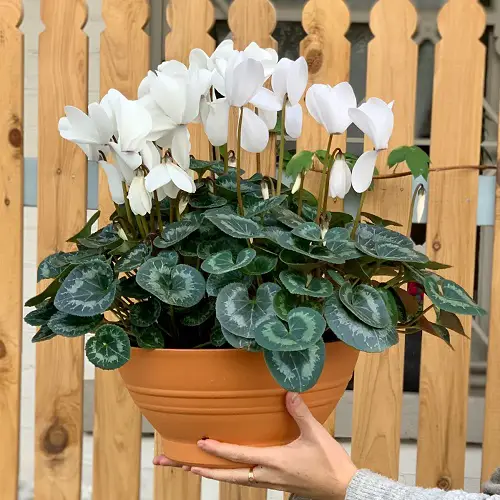The colorful Cyclamen flowers are any gardener’s delight! If you want to know how to keep them blooming for a long time – keep reading!
Cyclamen care is not that troublesome if you follow the right set of rules, which we’ll guide you through for the best flowers!
Different Types of Cyclamen Varieties
Quick Cyclamen Plant Information
A stunning perennial, this flower has its roots in the Mediterranean Basin, but it is quite common in different parts of the globe, too.
Different species have different blooming times and can span from summer to late winter to early spring – however, in temperate regions, the plant usually flowers in cold weather.
Best Cyclamens to Grow
- Cyclamen persicum: Popular as Florist’s Cyclamen, it stands out with its variegated leaves.
- Cyclamen coum: Grows small pink flowers and is quite hardy.
- Cyclamen hederifolium: The plant has ivy-type leaves and blooms pink-white flowers.
- Cyclamen purpurascens: This one grows sweet-smelling blossoms from summer to autumn.
- Cyclamen repandum: It flowers in spring and has deeply lobed foliage.
Propagating Cyclamen
The most effective method to grow these flowers is through division, as most of them fail to root from cuttings and don’t produce seeds, either.
As the plant remains dormant in summer, it is the best time to propagate it.
Start by taking a healthy plant out of the container and look for plump tubers – if there are small offsets, snip them out using a shear. Ensure that the section you cut has at least one ‘growth eye.’
That’s pretty much it! You’re almost done! Plant the section in a pot filled with a peat-based growing medium. Water well, and place the container where it gets plenty of bright but indirect light.
Choosing a Container for Cyclamen
If you are starting the plant from division, a 6-8-inch pot would be just fine and would support the plant for a few years. If you have got the plant from a garden center, transfer it to a pot that’s one size bigger than what the plant came in.
Post that, when you see the roots popping out of the topsoil, re-pot the plant into a one-size bigger container than the old one.
Requirements for Growing Cyclamen
Sunlight
Like every flower, this one, too, loves sunlight but not the harsh afternoon exposure, especially if you live in a warmer zone.
Exposing the plant to 3-4 hours of mild morning sun and then plenty of indirect light for the rest of the day is a super recipe for the best growth!
Soil
Avoid using 100% garden soil – instead, mix equal parts of peat moss or coco coir, along with perlite or vermiculite and fine bark chips. Also, add a handful of sand along with an equal quantity of well-rotted manure.
Cyclamens prefer a pH between 5.5 and 6.5 – get a tester and ensure the level is within this range.
Water
The best way is to water the soil thoroughly when its top inch feels dry to the touch. Do not moisten the plant daily, and avoid wetting the foliage and flowers.
Also, these flowers demand a little care, so do not let the soil go dry completely.
Temperature
Cyclamens can tolerate temperatures up to about 68°F (20°C). Beyond this, the plant will start to show signs of stress, like the dropping of leaves and flowers.
The perfect range is between 60°F to 76°F (15°C to 24°C). It can withstand temperatures as low as 40°F (4°C) without any issues, too! However, do remember that these flowers are not frost tolerant, so avoid exposing them to freezing temperatures.
Cyclamen Care

Fertilizer
The plant will be more than happy to be fed with a balanced liquid fertilizer, diluted to 1/2 of its strength, once in 3-4 weeks.
To promote blooming, you can go for a potassium-rich blend as it promotes blooming. 10-30-20 or 15-30-15 are the best choices.
Avoid feeding cyclamen in its dormancy stage, which is spring or early summer.
Humidity
These flowers love humidity – in the levels of around 40-50%. Indoors (if the air is dry), it would be a good idea to keep their pot on a tray filled with pebbles and water. You can also get a humidifier.
For outdoors, group/grow cyclamens together to create a microclimate.
Pests and Diseases
Spider mites are the biggest enemies of these flowers and may result in leaf curling. The plants are also susceptible to botrytis, which makes the leaves turn yellow and develop brown spots.
Avoid overwatering cyclamens to keep most of the potential diseases at bay.
Important Pointers
- Cyclamens flower best in winter, so ensure they get plenty of direct sunlight during this time.
- Come spring, and the plant will enter a semi dormant stage – indicating that it should be moved to a shady location.
- The cyclamens leaves will start to turn yellow at the arrival of summer.
Can Cyclamens Bloom Again?
Yes, they surely do! Don’t treat them as annuals and throw away after they have flowers – what you can do is:
Snip away the spent flower stems from the base and yellowing or damaged leaves. When the plant is done blooming, cut down the watering – this will help cyclamens to enter dormancy, which can last 2-3 months.
After dormancy (fall) resume watering and start exposing the plant to indirect sunlight – it will bloom again in no time!
Are Cyclamens Toxic?
While not exactly, as long as you are not taking them out and eating their roots and tubers – they have toxic compounds. Consuming can cause nausea, excessive drooling, vomiting, and diarrhea.
The best bet is to keep the plants away from pets and children to be on the safe side.




